Content
Hydrangeas in landscape design have become a real trend in the field of decorating the garden area. They are distinguished by rich decorative qualities, attractive appearance and abundant flowering.
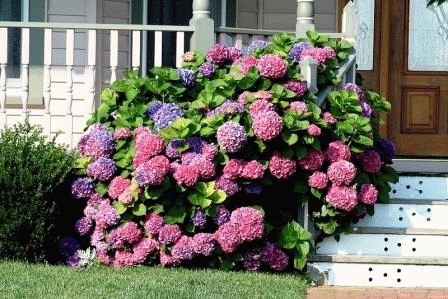
Most species are unpretentious in content, so they are an excellent option for use in landscape design.
Features of hydrangea in landscape design
Landscape designers have singled out hydrangeas as one of the most valuable materials. They have a fairly compact size, lend themselves well to shaping and are able to maintain decorative qualities throughout the season. They also differ in the duration and uniqueness of flowering: the decorative properties of plants are not due to "real" flowers, but to large, brightly colored sepals.
Initially, they have a greenish tint, which changes to white, pink, blue and other colors as they grow, depending on the variety. Sepals bloom for two to three months. In the autumn period, the inflorescences remain on the bush, drying out only a little before the onset of frost.
Another advantage of the plant for landscape design purposes is its high resistance to disease and pest damage.
What types and varieties of hydrangeas are used in landscape design
Depending on the type and variety, shrubs are distinguished by size, growth characteristics, development and maintenance rules. That is why, before planting on the site, it is important to familiarize yourself with the features of each variety and choose the most suitable option.
Paniculata
Panicle hydrangea is a large shrub, less often a small tree up to 2 m in height. The crown is round and dense, with elliptical or ovoid leaves up to 12 cm in length. Flowers are collected in long broad-pyramidal inflorescences up to 25 cm. The first flowering begins at 4-5 years of growth. It runs from June to October.
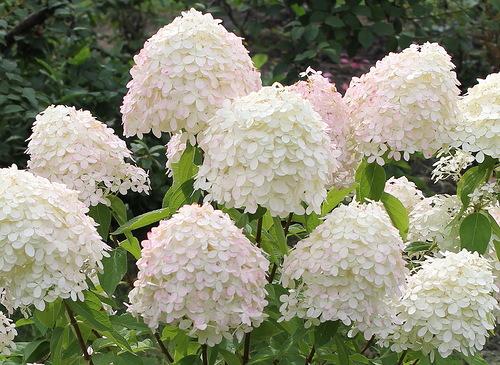
The plant is distinguished by its exactingness to the level of soil fertility and moisture, adapts well to urban conditions and a sharp drop in temperature in spring
Flexibility to pruning and shaping and durability allow designers to create various landscape compositions with paniculate hydrangea: from balls and trees on a trunk to hedges and trellises.
Tree-like
Treelike hydrangea is one of the most famous species, which is actively used for landscaping the site. It is presented in the form of a low shrub 1-1.5 m in height (under optimal growing conditions - up to 3 m), with a rounded crown and pubescent shoots. The leaves are ovoid or elliptical in shape, reaching 6 to 20 cm in length. On the shoots are infertile white flowers (up to 2 cm in diameter), which form corymbose panicles. The active flowering process begins in the first half of July and lasts until October. It occurs on annual growths (shoots of the current year).
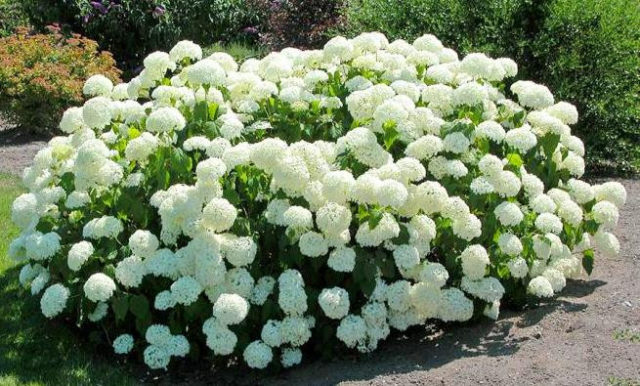
Shrub propagation takes place with the help of green cuttings, layering, as well as division
This species is quite picky about the level of fertility and soil moisture. It tolerates adding lime to the ground well. In the southern steppe areas, the plant may lack moisture. Has a high level of frost resistance.
In landscape design, tree hydrangea is used to create single and group compositions, edges, unshaped hedges. It is often combined with roses, lilies, clematis.
Dubolistnaya
Oak-leaved hydrangea is a shrub up to 2 m in height.
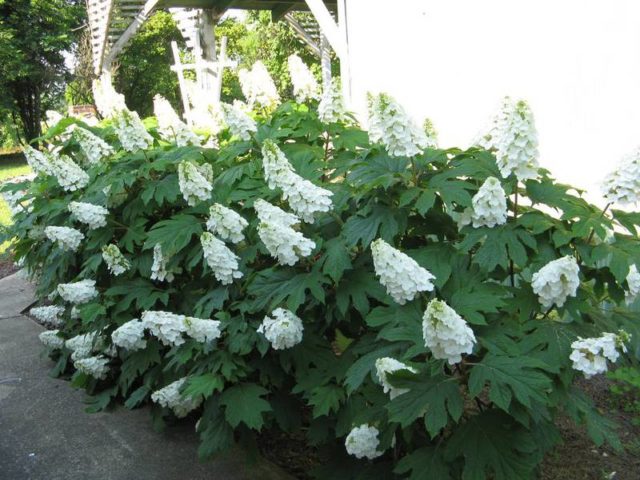
This species is distinguished by red felt shoots and 3-7-lobed leaves.
Externally, the foliage is similar to the foliage of an oak, which determines the specific name. It is a shrub with paniculate inflorescences from 10 to 30 cm in length. They are formed by sterile fruiting white flowers up to 3 cm in size. During the flowering period, they change their color to purple. Flowering occurs in June-July, and the ripening of the fruits of the bolls - in mid-September.
Large-leaved
Large-leaved hydrangea is an ornamental shrub from 1 to 2 m in height. It has erect shoots and bright green ovoid leaves.
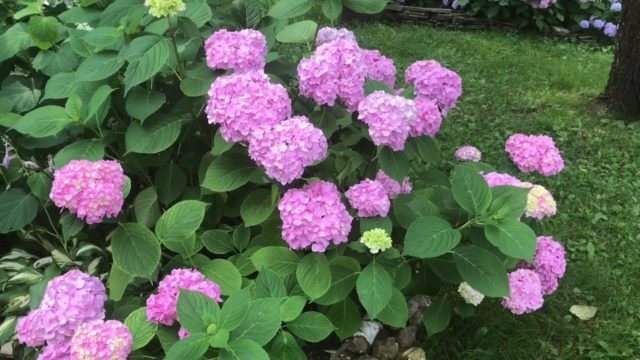
Large pink sterile flowers reach 3-3.5 cm in diameter
Garden species are distinguished by the spherical shape of the inflorescences that appear on the tips of the shoots of the last year. Bloom lasts from July to August. The shrub is widespread in Europe. In landscape design near a private house, specimens of large-leaved hydrangea of pink, white, blue and bright crimson colors with two-color, double or lace flowers are most often used.
The bush is characterized by a fairly good winter hardiness, but it is most difficult to preserve its flower buds in winter. This is due to their location: they are located at the tips of last year's shoots, which is why they are less resistant to frost. If the shoots are damaged in the winter, the shrub will not bloom.
Gardeners have come up with several ways to preserve them:
- transplanting plants into containers for transferring to light rooms with lower temperatures, winter cellars and gardens;
- shelter in open ground with a layer of earth or spruce branches;
You can also use special protective shelters.
Pereshkovaya
The petiolate hydrangea is a climbing plant with suction cups, with the help of which it is able to attach to a support at a height of more than 10 m. If there is no support, the species spreads along the ground. It is characterized by broadly ovate, long-petiolate shiny leaves of a dark green color up to 8 cm in length. Their base is heart-shaped or pointed. On the shoots there are white-pink flowers-honey plants, forming corymbose, loose panicles up to 20 cm in diameter. The first 2-4 years, the growth of young seedlings is slow, but soon increases in intensity.
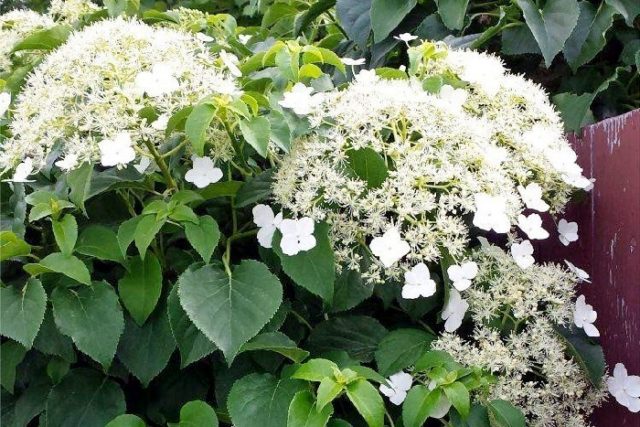
The species is distinguished by its exactingness to the level of soil fertility, it grows and develops better on moist loamy soil
It adapts to partial shade, but active flowering of the shrub is possible only in open sunny areas. Reproduction can take place by cuttings or layering.
Petiole hydrangea is often decorated with walls, gazebos, balconies, arches, as well as tree trunks.
Types of compositions with hydrangea in landscape design
Hydrangea is a great option for single and group plantings, as well as for creating individual landscape compositions. Shrubs up to 5 years old must be constantly replanted, so they can decorate different parts of the garden. Good flexibility in cutting and shaping allows you to create compositions of different shapes and sizes.
Shrubs are actively used to decorate a garden in the Russian style: they are planted near other types of bushes and trees, taking into account the composition of the soil. Reacting to the components inside the soil, landscape compositions can change color: in a slightly alkaline soil, the flowers become bright pink, in an acidic soil - deep blue. The reason for this is the lack of iron in the soil.The optimal content of the element in the soil helps to achieve the required color of the shrub.

Planting hydrangeas near natural or artificial reservoirs gives the garden a picturesque and relief look
The plant has the ability to quickly adapt to modeling, which allows you to create bright, flowering figures from different varieties. In this case, it is important to take into account the requirements for the climate of each type of shrub.
Single planting is one of the most common uses for hydrangeas in landscaping. They are planted on a well-groomed lawn, focusing on the preferences of the species for lighting.

By grouping several shrubs together, you can create flowering glades and front gardens
Another functional use in landscape design is the planting of flowering shrubs to divide the garden into different parts, as well as to create hedges.
You can also use a hydrangea to plant a monochrome English flower garden. In this case, all elements of the landscape composition are selected according to the principle of the same color during the flowering period. At the same time, it is important that an equal distance is maintained between the plants.
Hydrangeas are also used to create flower beds with the addition of decorative herbaceous plants. The shrub is placed in the middle of the composition. Often in landscape design, hydrangeas are planted at the entrance area to the garden in flowerpots or flower beds.
What is hydrangea combined in landscape design
Decorative properties and unpretentious maintenance make it easy to combine hydrangea with other types of plants to create unusual landscape compositions in the garden. Some combinations are in greatest demand among designers.
Conifers and hydrangea in landscape design
One of the most famous and simplest combinations is combining hydrangeas with conifers. In addition to beauty, such a composition is well suited for the normal development of both types of plants. Conifers tend to oxidize the soil, which is of great benefit to the growth of hydrangeas. Moreover, due to their high growth, conifers are able to create a small partial shade for shrubs.
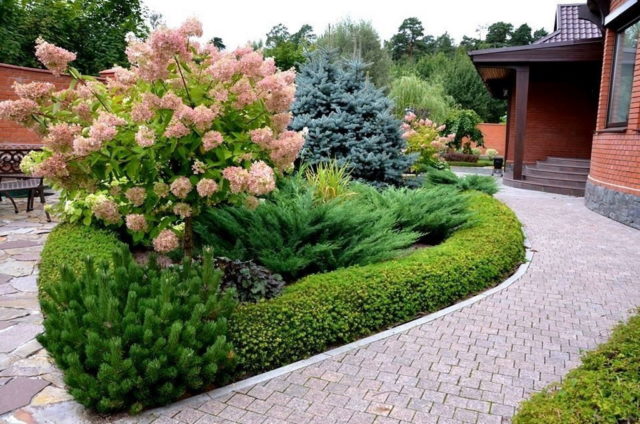
Coniferous resin tends to attract some insects: for example, ladybugs, which protect the garden from aphids
Hydrangea and badan in landscape design
Badan is quite unusual, but a good option for planting with hydrangea. Its flowering period runs from April to May.
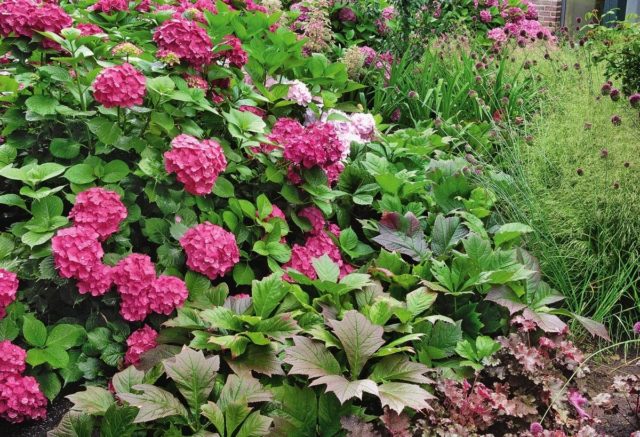
In the summer, the badan foliage takes on an unusual shade that contrasts perfectly with the color of the hydrangea.
Hydrangea and boxwood in landscape design
A combination of tree hydrangea and boxwood will be a good option for creating a lush blooming garden corner in a natural style, as well as mixborders.
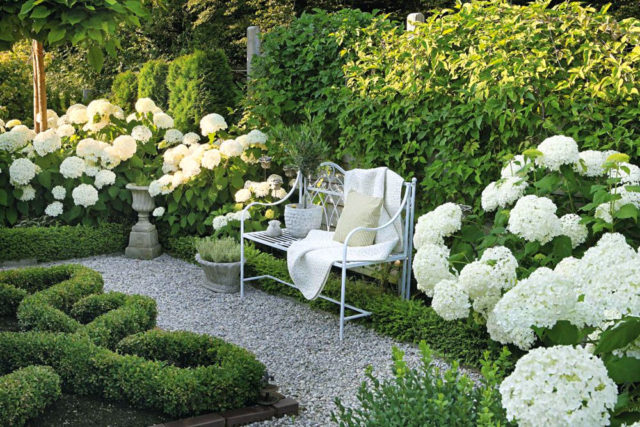
However, it is better not to use topiary forms of boxwood, but to replace it with spreading bushes of mock orange, barberry, lilac or spirea
Juniper and hydrangea in landscape design
The combination of hydrangea and juniper is one of the most commonly used options in landscaping.

The rich variety of ephedra varieties allows you to combine these two varieties in completely different ways.
So, a high rocky juniper is often used to create a living green fence, which is planted near a flowering shrub.
Barberry and hydrangea in landscape design
By combining hydrangea with barberry, landscape designers form flower beds and mixborders. For this, panicle hydrangea is best suited: as it grows, the bottom of the plant is slightly bare, and fluffy perennials are placed around the shrub to block it.
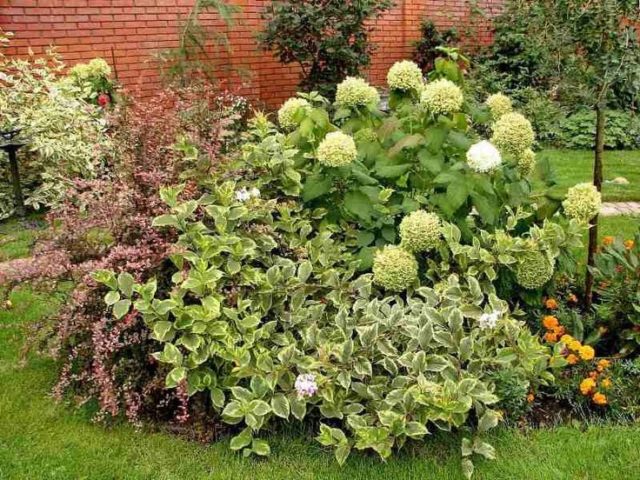
Often barberry is used to form a flower garden.
The barberry bush has a beautiful voluminous crown and an unusual color, which goes well with pink, blue and white hydrangeas
Hydrangea care
Despite the unpretentiousness of the plant, caring for a hydrangea has several features that are important to familiarize yourself with before buying it for a site for landscape design.
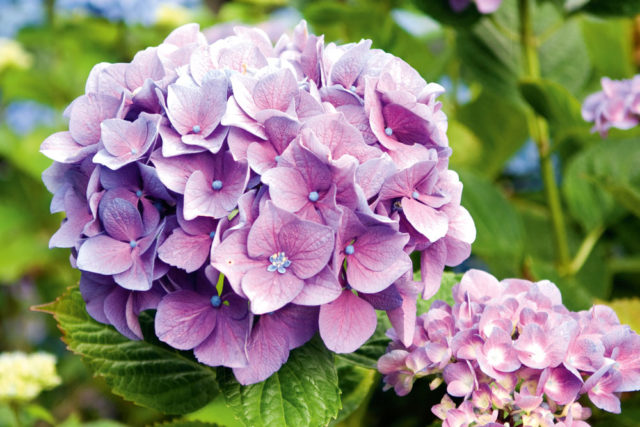
The shrub grows and develops best in shaded areas, not tolerating direct sunlight
The planting soil must be well-drained, contain a lot of organic matter and have a high level of acidity (5-5.5 units). Another necessary condition is a sufficient degree of soil and air moisture.
Planting shrubs in open ground occurs in the spring, after growing in a greenhouse. If desired, you can purchase ready-made seedlings for planting in special containers (with a closed type of root system). You can plant such plants in the ground at any time of the year.
Reproduction takes place using rooted cuttings or layering. Hydrangea needs 3-4 times feeding with complex fertilizers and organic substances:
- first feeding - in the spring, as soon as the shrub has begun to grow;
- second - during the budding period;
- third and fourth time - during active flowering (once every 3-4 weeks).
Watering is carried out as needed, it is important not to allow the soil under the plant to dry out. During the summer drought, hydrangea is watered 2 times a week, 3-4 buckets per bush. To obtain larger inflorescences in the spring, it must be cut off, removing all unusable shoots.
Panicle and tree hydrangeas survive the winter well without the need for additional shelter. It is enough just to carry out mulching or hilling of the trunk circle.
Particular attention should be paid to young seedlings, since adult plants become more hardy and easier to adapt to external conditions.
You can find out more information about the use of hydrangea in the garden landscape in the video:
Photo of hydrangea in garden landscaping
The rich variety of hydrangea varieties allows you to create many unique and unusual compositions. Below are some examples of its use in landscape design.
One of the most common uses for hydrangea in landscaping is to create a flower bed with a shrub in the middle, as shown in the photo:
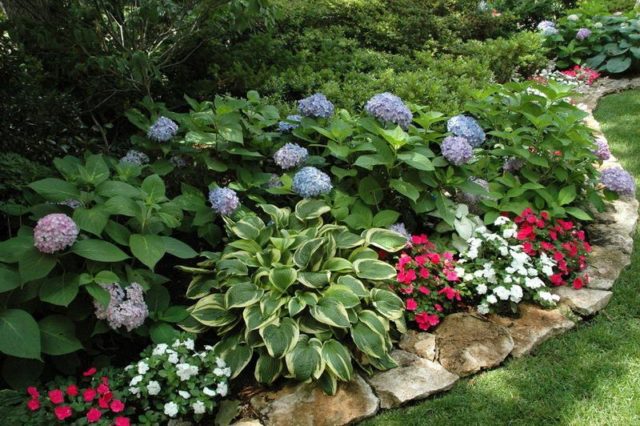
Blue hydrangea has a central role in this composition.
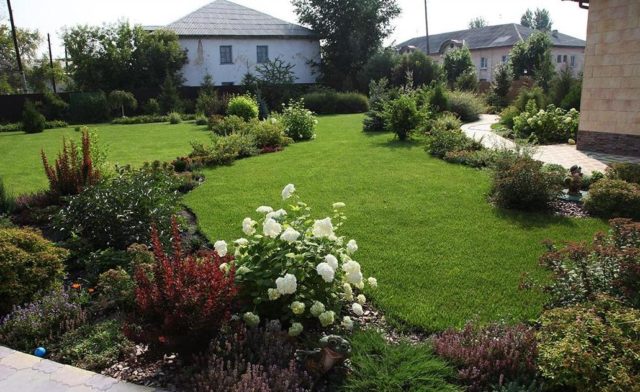
Planting a mixborder in the garden with hydrangea in the composition is a great option for playing on the contrast of shades
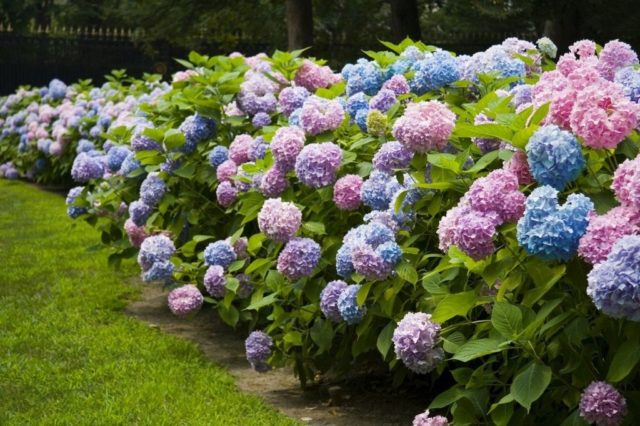
A living landscape hedge of flowering bushes will allow you to zone the site
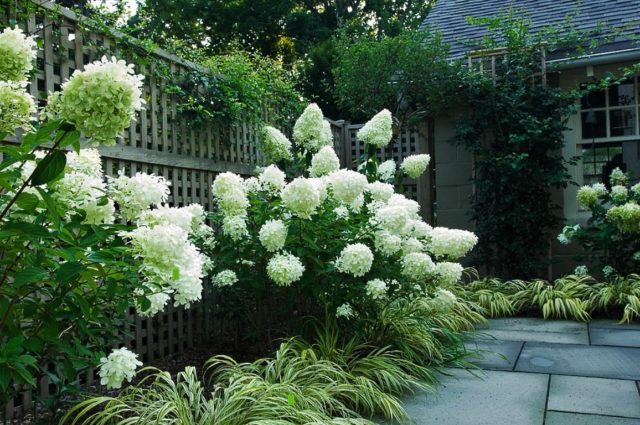
The combination of different types of hydrangea in group plantings looks great along the fence
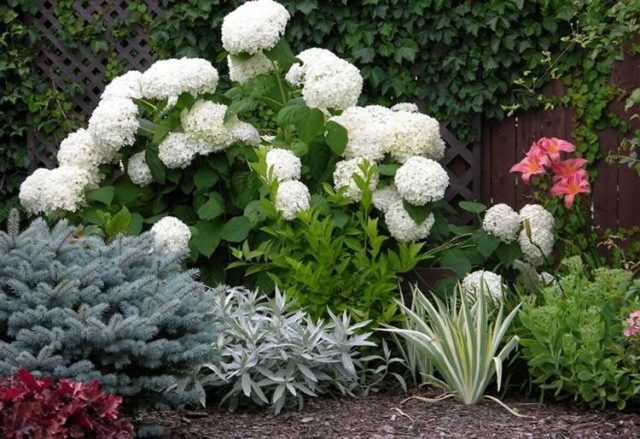
Combining hydrangeas with conifers is an interesting option for creating a flower bed

Planting a mixborder in the garden with hydrangea in the composition is a great option for playing on the contrast of shades

A living landscape hedge of flowering bushes will allow you to zone the site

The combination of different types of hydrangea in group plantings looks great along the fence

Combining hydrangeas with conifers is an interesting option for creating a flower bed

Planting a mixborder in the garden with hydrangea in the composition is a great option for playing on the contrast of shades

A living landscape hedge of flowering bushes will allow you to zone the site

The combination of different types of hydrangea in group plantings looks great along the fence

Combining hydrangeas with conifers is an interesting option for creating a flower bed
Conclusion
Hydrangea in landscape design is one of the main innovations in the field of garden decoration. Shrubs are undemanding to maintain, easily tolerate winter and go well with many types of plants. In addition, hydrangeas can retain their decorative properties for a long time, giving the garden a unique look.








